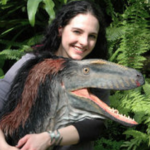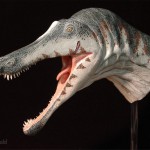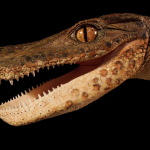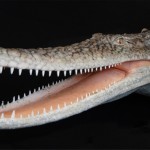By Danielle Prieur
Erin Fitzgerald bends over a cast of a dinosaur as she creates a reptile-like texture for its skin, painting it alternately brown and black. She inserts its mountain lion eyes and glues brown and black feathers on its head.
Fitzgerald isn’t just imagining what a Raptorex might have looked like. She is basing her model on the fossils donated to University of Chicago paleontologist Paul Sereno.
Stephanie Baumgart, a graduate student in Sereno’s lab remembers watching Fitzgerald create her model. “The skull of Raptorex featured small crests just in front of its eyes, and so Erin painted the skin covering the crests in her reconstruction a different color to make them follow the visual pattern,” she said.
“An increasing amount of scientific evidence suggests feathers evolved in many theropod dinosaurs, so Erin added feathers running down the back of Raptorex’s neck. She also takes a bit of creative liberty, adding a couple scratches on the nose of Raptorex, perhaps from a run-in with another dinosaur,” said Baumgart.
Along with these fossils, Fitzgerald uses clues from paleontology research papers on similar dinosaurs. Then she interweaves her knowledge of the anatomy of dinosaurs and living reptile species to determine what a 125-million-year old dinosaur might have looked like before she completes her life-size models and smaller drawings and paintings.
In the second-floor studio where she works, Fitzgerald is surrounded by red, rubber molds, pieces of casting plaster and, of course, models of dinosaurs she and partner paleontologist Tyler Keillor haves made based on the fossils Sereno and his team have collected from more than over two decades in the field.

In second or third grade, you probably learned about dinosaurs. You might have read about them in picture books or watched animations or videos of them online. But if you were really lucky, you got to “meet” the dinosaurs at your local museum.
If you grew up in Chicago, you probably visited the Field Museum where Sue, the famous T. Rex, occupies the main hall and you might have explored the skeletons of many other dinosaurs elsewhere in the museum. But down the decades, the models that bring the dinosaurs to life were and still are made by paleoartists like Fitzgerald whose creations have been part of traveling exhibits at the National Museum of Nature and Science in Tokyo.
“A paleoartist is somebody who works with scientists to reconstruct [something] that existed that we can no longer see. They could [recreate] anything from various time periods: animals before dinosaurs or animals that lived with human beings before they went extinct – anything that’s not around anymore,” said Fitzgerald.
Fitzgerald joined Sereno’s lab as a preparator in 2007 and then trained with Keillor as the resident paleoartist. Like most paleoartists, Fitzgerald has a background in both paleontology and art. She graduated from the University of Illinois at Chicago in 2007 with her bachelors of art in graphic design, while volunteering in the dinosaur fossil preparation lab at the Field Museum. She also joined several digs with a team from the Burpee Museum of Natural History, in Rockford. Of course she sketched in the field.
For the past nine years, Fitzgerald has combined her obsession for dinosaurs, with painting, drawing and modeling to recreate the dinosaurs Sereno’s team finds as fossils. From the color and texture of their skin, to the shape and color of their eyes, to the color and thickness of their feathers – she fills in all the details. She even imagines and researches what the environment they lived in during the Mesozoic Era might have looked like, from 125 million to 65 million years ago.
Her models and drawings of dinosaurs appear in programs featuring Sereno’s lab, in scientific magazines and papers that cite Sereno, in the popular press and in traveling exhibits for the Field Museum. But not every paleontology lab has a paleoartist.
“We’re very fortunate to work for Paul [Sereno] who is an artist himself. He highly values what an artist can put into [the work],” said Fitzgerald. “The art helps out because people can relate to it a lot better when they can see things in the flesh.”
Sereno took art classes as an undergraduate. He collaborates closely with Fitzgerald on her paleoart to produce “truly authentic models,” he said.
On a hot afternoon in the Niger desert in 2011, Fitzgerald joined Sereno on a dig studying human remains found at an ancient burial site. Fitzgerald went to work, drawing dig maps before the paleontologists began excavating. Unlike most paleoartists, Fitzgerald’s drawings begin in the field when she goes on digs with Sereno and his team.
She acts as the “collection assistant” on digs, taking pictures and drawing specimens on maps before they’re excavated. She uses these pictures to draw the dinosaurs they find as well as to create a more complete database of the lab’s collection. Usually, she helps to package fossils in jackets, protective coats of plaster, where they’re shipped back to the lab. When she returns to the lab, she opens the jackets and helps to prepare the fossils for conservation.
It’s after the fossils are prepared, carefully taken out of the rock and cleaned, that the work of most paleoartists begins and that’s when Fitzgerald turns to making molds. Most of her molds, made out of a red, rubbery material, are made by “visually dividing” the fossil into two parts: for, example she might start by making a mold of the top half of the cranium of a dinosaur and then move to making a mold of it’s teeth. This protects the original fossil from breaking when the mold is taken off and creates a more accurate representation.

After Fitzgerald makes casts from the molds, the casts are photographed as the actual fossils have a blue tint that does not photograph well. These casts are studied by visiting paleontologists, and are lent out as part of the fossil collection. The process could end there, but for Fitzgerald and her life-size models of dinosaurs, the real work has just begun.
She reads research papers to gather the smallest clues that help her imagine how the dinosaurs looked when they lived. For example, researchers in China discovered feather prints in fossils indicating the size and type of feathers on certain dinosaurs. She also studies cadavers of modern vertebrates that are kept in the lab, and she looks at pictures of modern reptiles. From this research, she creates the texture of the skin, determining whether use mammal or reptile eyes, and what type and color of feathers to use.
“[Erin] researches the anatomy and coloration of living animals and applies that knowledge to her creations. Erin believes that, while the final product of a reconstruction is still a hypothesis, artistic decisions for the muscle placement and coloration should have a reason based in scientific knowledge,” Baumgart said.
Fitzgerald’s favorite model is Raptorex, the first one she made for Sereno’s lab. Although her current work is focused on preparing fossils from past digs, she still paints and draws dinosaurs and other fossils at home. Many of her paintings and drawings are auctioned off for charity, like the ones she’s auctioning at Burpee later this month. And she will begin to mentor a new student from the University of Illinois at Chicago in animal reconstruction this month.

“[It] goes back to childhood obsession of working on these things. It’s a little different working on them and seeing them versus the obsession you had as a kid,” she said. “Now I go and dig them up and open them and put them back together. My favorite part is the patience and puzzle of putting bones together.”
Outside of the lab, Baumgart said Fitzgerald uses this obsession for a good cause.
“She’s donated many gorgeous charcoal drawings featuring skulls of extinct animals to auctions at paleontology conferences,” said Baumgart. “Erin is also involved in outreach, [she will] teach a scientific illustration workshop for children during the Burpee Museum’s annual PaleoFest coming up in March.”
Through her paleoart, she helps us to experience both the art and science of dinosaurs.









